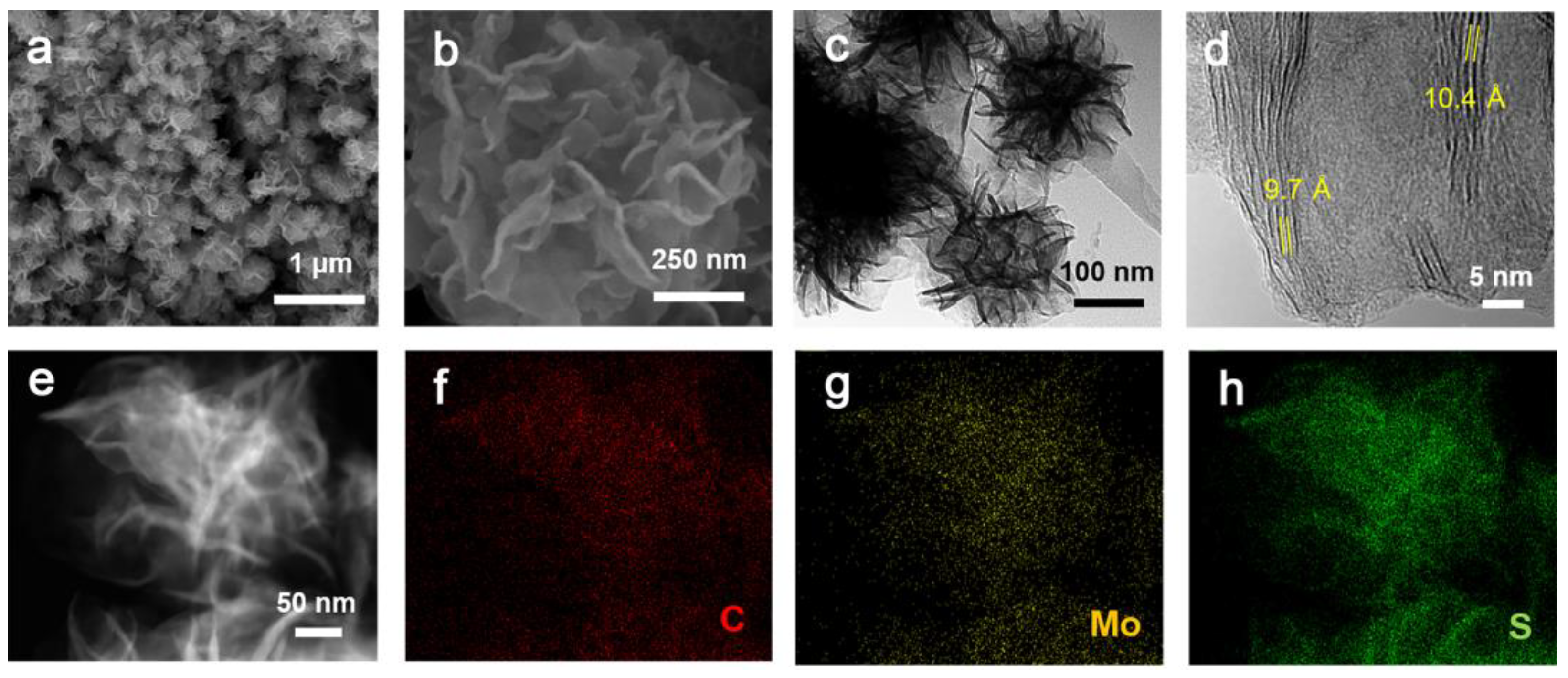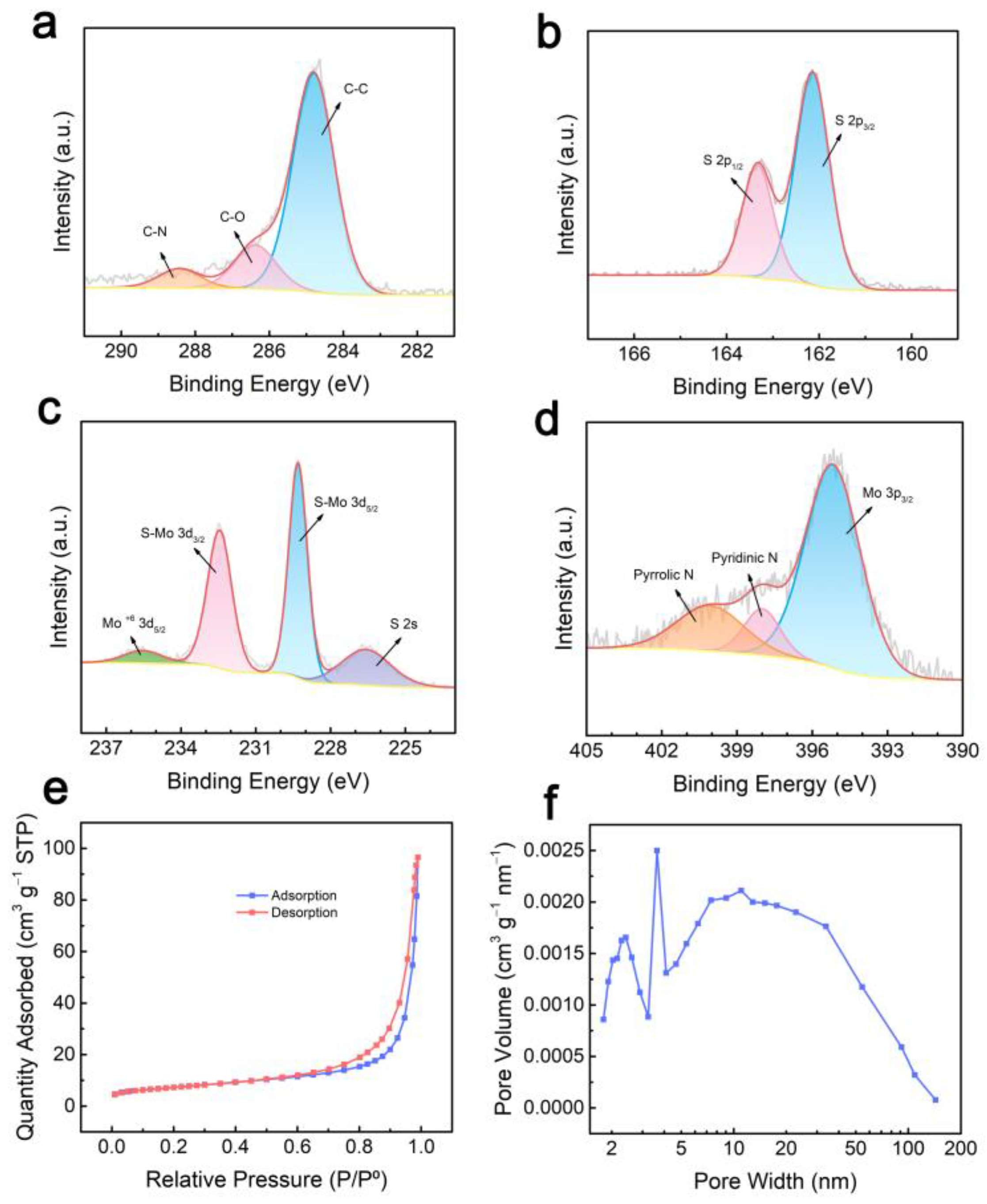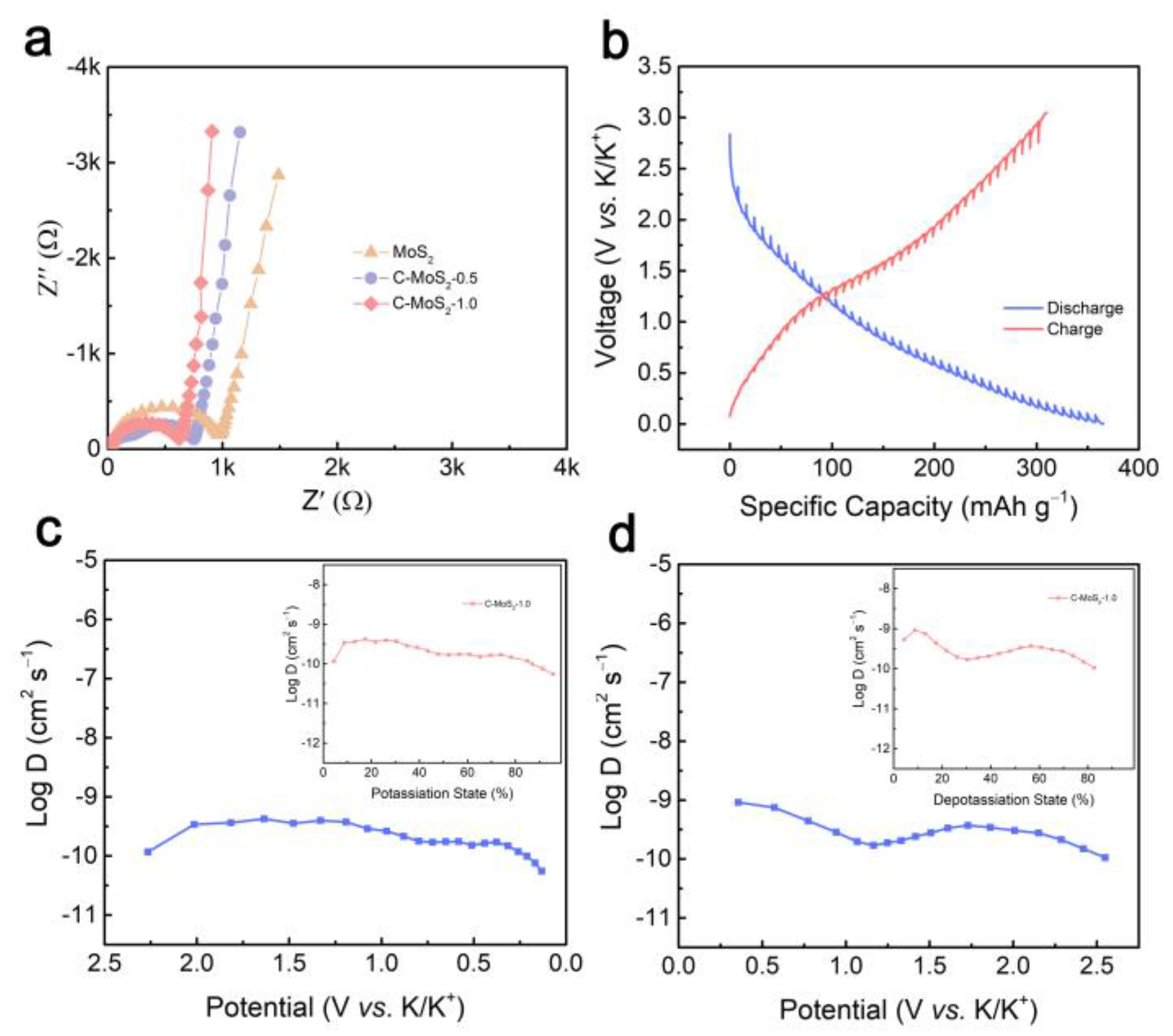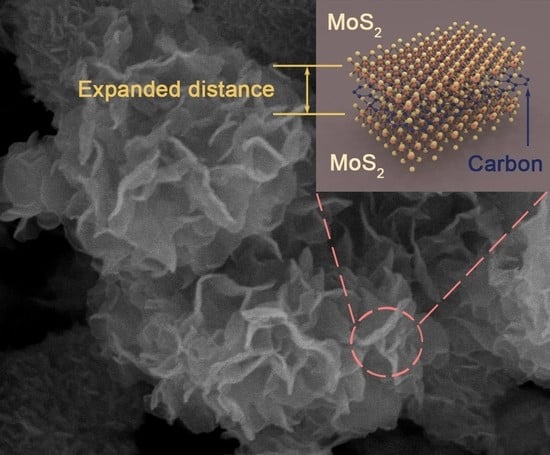Interlayer-Expanded MoS2 Enabled by Sandwiched Monolayer Carbon for High Performance Potassium Storage
Abstract
:1. Introduction
2. Results and Discussion
3. Materials and Methods
4. Conclusions
Author Contributions
Funding
Institutional Review Board Statement
Informed Consent Statement
Data Availability Statement
Conflicts of Interest
References
- Min, X.; Xiao, J.; Fang, M.; Wang, W.; Zhao, Y.; Liu, Y.; Abdelkader, A.M.; Xi, K.; Kumar, R.V.; Huang, Z. Potassium-ion batteries: Outlook on present and future technologies. Energy Environ. Sci. 2021, 14, 2186–2243. [Google Scholar] [CrossRef]
- Hosaka, T.; Kubota, K.; Hameed, A.S.; Komaba, S. Research Development on K-Ion Batteries. Chem. Rev. 2020, 120, 6358–6466. [Google Scholar] [CrossRef]
- Zhang, W.; Yin, J.; Wang, W.; Bayhan, Z.; Alshareef, H.N. Status of rechargeable potassium batteries. Nano Energy 2021, 83, 105792. [Google Scholar] [CrossRef]
- Zhang, Q.; Cheng, X.; Wang, C.; Rao, A.M.; Lu, B. Sulfur-assisted large-scale synthesis of graphene microspheres for superior potassium-ion batteries. Energy Environ. Sci. 2021, 14, 965–974. [Google Scholar] [CrossRef]
- Yuan, F.; Lei, Y.; Wang, H.; Li, X.; Hu, J.; Wei, Y.; Zhao, R.; Li, B.; Kang, F.; Zhai, D. Pseudo-capacitance reinforced modified graphite for fast-charging potassium-ion batteries. Carbon 2021, 185, 48–56. [Google Scholar] [CrossRef]
- Wang, B.; Yuan, F.; Yu, Q.; Li, W.; Sun, H.; Zhang, L.; Zhang, D.; Wang, Q.; Lai, F.; Wang, W. Amorphous carbon/graphite coupled polyhedral microframe with fast electronic channel and enhanced ion storage for potassium ion batteries. Energy Storage Mater. 2021, 38, 329–337. [Google Scholar] [CrossRef]
- Luo, P.; Zheng, C.; He, J.; Tu, X.; Sun, W.; Pan, H.; Zhou, Y.; Rui, X.; Zhang, B.; Huang, K. Structural Engineering in Graphite-Based Metal-Ion Batteries. Adv. Funct. Mater. 2021, 32, 2107277. [Google Scholar] [CrossRef]
- Cheng, X.; Sun, Y.; Li, D.; Yang, H.; Chen, F.; Huang, F.; Jiang, Y.; Wu, Y.; An, X.; Yu, Y. From 0D to 3D: Dimensional Control of Bismuth for Potassium Storage with Superb Kinetics and Cycling Stability. Adv. Energy Mater. 2021, 11, 2102263. [Google Scholar] [CrossRef]
- Huang, K.; Xing, Z.; Wang, L.; Wu, X.; Zhao, W.; Qi, X.; Wang, H.; Ju, Z. Direct synthesis of 3D hierarchically porous carbon/Sn composites via in situ generated NaCl crystals as templates for potassium-ion batteries anode. J. Mater. Chem. A 2018, 6, 434–442. [Google Scholar] [CrossRef]
- Zhang, D.; Chen, B.; Wang, S.; Shen, Y.; Wang, C.; Wang, Z.; Wang, L.; Cheng, Y. Boosting Reversibility of Conversion/Alloying Reactions for Sulfur-Rich Antimony-Based Sulfides with Extraordinary Potassium Storage Performance. ACS Mater. Lett. 2022, 4, 2604–2612. [Google Scholar] [CrossRef]
- Huang, M.; Xi, B.; Mi, L.; Zhang, Z.; Chen, W.; Feng, J.; Xiong, S. Rationally Designed Three-Layered TiO2@amorphous MoS3@Carbon Hierarchical Microspheres for Efficient Potassium Storage. Small 2022, 18, 2107819. [Google Scholar] [CrossRef] [PubMed]
- Liu, S.; Kang, L.; Henzie, J.; Zhang, J.; Ha, J.; Amin, M.A.; Hossain, M.S.A.; Jun, S.C.; Yamauchi, Y. Recent Advances and Perspectives of Battery-Type Anode Materials for Potassium Ion Storage. ACS Nano 2021, 15, 18931–18973. [Google Scholar] [CrossRef] [PubMed]
- Luo, W.; Wan, J.; Ozdemir, B.; Bao, W.; Chen, Y.; Dai, J.; Lin, H.; Xu, Y.; Gu, F.; Barone, V.; et al. Potassium Ion Batteries with Graphitic Materials. Nano Lett. 2015, 15, 7671–7677. [Google Scholar] [CrossRef] [PubMed]
- Wang, S.; Cui, X.; Jian, C.; Cheng, H.; Niu, M.; Yu, J.; Yan, J.; Huang, W. Transition Metal Dichalcogenides: Stacking-Engineered Heterostructures in Transition Metal Dichalcogenides. Adv. Mater. 2021, 33, 2170127. [Google Scholar] [CrossRef]
- Ren, X.; Zhao, Q.; McCulloch, W.D.; Wu, Y. MoS2 as a long-life host material for potassium ion intercalation. Nano Res. 2017, 10, 1313–1321. [Google Scholar] [CrossRef]
- Jia, B.; Yu, Q.; Zhao, Y.; Qin, M.; Wang, W.; Liu, Z.; Lao, C.; Liu, Y.; Wu, H.; Zhang, Z.; et al. Bamboo-Like Hollow Tubes with MoS2/N-Doped-C Interfaces Boost Potassium-Ion Storage. Adv. Funct. Mater. 2018, 28, 1803409. [Google Scholar] [CrossRef]
- Wang, H.; Niu, J.; Shi, J.; Lv, W.; Wang, H.; van Aken, P.A.; Zhang, Z.; Chen, R.; Huang, W. Facile Preparation of MoS2 Nanocomposites for Efficient Potassium-Ion Batteries by Grinding-Promoted Intercalation Exfoliation. Small 2021, 17, 2102263. [Google Scholar] [CrossRef]
- Hu, J.; Xie, Y.; Zhou, X.; Zhang, Z. Engineering Hollow Porous Carbon-Sphere-Confined MoS2 with Expanded (002) Planes for Boosting Potassium-Ion Storage. ACS Appl. Mater. Interfaces 2020, 12, 1232–1240. [Google Scholar] [CrossRef]
- Cui, Y.; Liu, W.; Feng, W.; Zhang, Y.; Du, Y.; Liu, S.; Wang, H.; Chen, M.; Zhou, J. Controlled Design of Well-Dispersed Ultrathin MoS2 Nanosheets inside Hollow Carbon Skeleton: Toward Fast Potassium Storage by Constructing Spacious “Houses” for K Ions. Adv. Funct. Mater. 2020, 30, 1908755. [Google Scholar] [CrossRef]
- Shi, Z.; Kang, W.; Xu, J.; Sun, Y.; Jiang, M.; Ng, T.; Xue, H.; Yu, D.; Zhang, W.; Lee, C. Hierarchical nanotubes assembled from MoS2-carbon monolayer sandwiched superstructure nanosheets for high-performance sodium ion batteries. Nano Energy 2016, 22, 27–37. [Google Scholar] [CrossRef]
- Li, Z.; Yin, L. Sandwich-like reduced graphene oxide wrapped MOF-derived ZnCo2O4–ZnO–C on nickel foam as anodes for high performance lithium ion batteries. J. Mater. Chem. A 2015, 3, 21569–21577. [Google Scholar] [CrossRef]
- Wang, J.; Sun, L.; Tan, H.; Xie, F.; Qu, Y.; Hu, J.; Gao, K.; Shi, X.; Wang, K.; Zhang, Y. Double-phase 1T/2H–MoS2 heterostructure loaded in N-doped carbon/CNT complex carbon for efficient and rapid lithium storage. Mater. Today Energy 2022, 29, 101103. [Google Scholar] [CrossRef]
- Liang, S.; Zhang, S.; Liu, Z.; Feng, J.; Jiang, Z.; Shi, M.; Chen, L.; Wei, T.; Fan, Z. Approaching the Theoretical Sodium Storage Capacity and Ultrahigh Rate of Layer-Expanded MoS2 by Interfacial Engineering on N-Doped Graphene. Adv. Energy Mater. 2021, 11, 2002600. [Google Scholar] [CrossRef]
- Saraf, M.; Natarajan, K.; Saini, A.K.; Mobin, S.M. Small biomolecule sensors based on an innovative MoS2-rGO heterostructure modified electrode platform: A binder-free approach. Dalton Trans. 2017, 46, 15848–15858. [Google Scholar] [CrossRef] [PubMed]
- Yu, X.; Zhao, G.; Liu, C.; Zhang, N. A MoS2 and Graphene Alternately Stacking van der Waals Heterostructure for Li+/Mg2+ Co-Intercalation. Adv. Funct. Mater. 2021, 31, 2103214. [Google Scholar] [CrossRef]
- Ganatra, R.; Zhang, Q. Few-Layer MoS2: A Promising Layered Semiconductor. ACS Nano 2014, 8, 4074–4099. [Google Scholar] [CrossRef]
- Li, X.; Li, J.; Ma, L.; Yu, C.; Ji, Z.; Pan, L.; Mai, W. Graphite Anode for Potassium Ion batteries: Current Status and Perspective. Energy Environ. Mater. 2021, 5, 458–469. [Google Scholar] [CrossRef]
- Liu, C.; Xie, H.; Sui, S.; Chen, B.; Ma, L.; Liu, E.; Zhao, N. Interface engineering of MoS2-based ternary hybrids towards reversible conversion of sodium storage. Mater. Today Energy 2022, 26, 100993. [Google Scholar] [CrossRef]
- Lim, H.; Yu, S.; Choi, W.; Kim, S.O. Hierarchically Designed Nitrogen-Doped MoS2/Silicon Oxycarbide Nanoscale Heterostructure as High-Performance Sodium-Ion Battery Anode. ACS Nano 2021, 15, 7409–7420. [Google Scholar] [CrossRef]
- Saraf, M.; Natarajan, K.; Mobin, S.M. Emerging Robust Heterostructure of MoS2-rGO for High-Performance Supercapacitors. ACS Appl. Mater. Interfaces 2018, 10, 16588–16595. [Google Scholar] [CrossRef]
- Zhao, C.; Yu, C.; Qiu, B.; Zhou, S.; Zhang, M.; Huang, H.; Wang, B.; Zhao, J.; Sun, X.; Qiu, J. Ultrahigh Rate and Long-Life Sodium-Ion Batteries Enabled by Engineered Surface and Near-Surface Reactions. Adv. Mater. 2018, 30, 1702486. [Google Scholar] [CrossRef] [PubMed]
- Gan, Z.; Yin, J.; Xu, X.; Cheng, Y.; Yu, T. Nanostructure and Advanced Energy Storage: Elaborate Material Designs Lead to High-Rate Pseudocapacitive Ion Storage. ACS Nano 2022, 16, 5131–5152. [Google Scholar] [CrossRef] [PubMed]
- Chen, L.; Chen, Z.; Chen, L.; Zhou, P.; Wang, J.; Yang, H.; Feng, Z.; Li, X.; Huang, J. The exfoliation of bulk MoS2 by a three-roller mill for high-performance potassium ion batteries. Appl. Surf. Sci. 2023, 615, 156253. [Google Scholar] [CrossRef]
- Li, X.; Qian, T.; Zai, J.; He, K.; Feng, Z.; Qian, X. Co stabilized metallic 1Td MoS2 monolayers: Bottom-up synthesis and enhanced capacitance with ultra-long cycling stability. Mater. Today Energy 2018, 7, 10–17. [Google Scholar] [CrossRef]
- Yao, K.; Xu, Z.; Ma, M.; Li, J.; Lu, F.; Huang, J. Densified Metallic MoS2/Graphene Enabling Fast Potassium-Ion Storage with Superior Gravimetric and Volumetric Capacities. Adv. Funct. Mater. 2020, 30, 2001484. [Google Scholar] [CrossRef]
- Zhou, Y.; Zhang, M.; Han, Q.; Liu, Y.; Wang, Y.; Sun, X.; Zhang, X.; Dong, C.; Jiang, F. Hierarchical 1 T-MoS2/MoOx@NC microspheres as advanced anode materials for potassium/sodium-ion batteries. Chem. Eng. J. 2022, 428, 131113. [Google Scholar] [CrossRef]
- Li, J.; Rui, B.; Wei, W.; Nie, P.; Chang, L.; Le, Z.; Liu, M.; Wang, H.; Wang, L.; Zhang, X. Nanosheets assembled layered MoS2/MXene as high performance anode materials for potassium ion batteries. J. Power Sources 2020, 449, 227481. [Google Scholar] [CrossRef]
- Chong, S.; Sun, L.; Shu, C.; Guo, S.; Liu, Y.; Wang, W.; Liu, H.K. Chemical bonding boosts nano-rose-like MoS2 anchored on reduced graphene oxide for superior potassium-ion storage. Nano Energy 2019, 63, 103868. [Google Scholar] [CrossRef]
- Xu, Y.; Bahmani, F.; Zhou, M.; Li, Y.; Zhang, C.; Liang, F.; Kazemi, S.H.; Kaiser, U.; Meng, G.; Lei, Y. Enhancing potassium-ion battery performance by defect and interlayer engineering. Nanoscale Horiz. 2019, 4, 202–207. [Google Scholar] [CrossRef] [PubMed]
- Vivier, V.; Orazem, M.E. Impedance Analysis of Electrochemical Systems. Chem. Rev. 2022, 122, 11131–11168. [Google Scholar] [CrossRef] [PubMed]
- Fang, G.; Wu, Z.; Zhou, J.; Zhu, C.; Cao, X.; Lin, T.; Chen, Y.; Wang, C.; Pan, A.; Liang, S. Observation of Pseudocapacitive Effect and Fast Ion Diffusion in Bimetallic Sulfides as an Advanced Sodium-Ion Battery Anode. Adv. Energy Mater. 2018, 8, 1703155. [Google Scholar] [CrossRef]
- Wang, P.; Sun, S.; Jiang, Y.; Cai, Q.; Zhang, Y.H.; Zhou, L.; Fang, S.; Liu, J.; Yu, Y. Hierarchical Microtubes Constructed by MoS2 Nanosheets with Enhanced Sodium Storage Performance. ACS Nano 2020, 14, 15577–15586. [Google Scholar] [CrossRef] [PubMed]





Disclaimer/Publisher’s Note: The statements, opinions and data contained in all publications are solely those of the individual author(s) and contributor(s) and not of MDPI and/or the editor(s). MDPI and/or the editor(s) disclaim responsibility for any injury to people or property resulting from any ideas, methods, instructions or products referred to in the content. |
© 2023 by the authors. Licensee MDPI, Basel, Switzerland. This article is an open access article distributed under the terms and conditions of the Creative Commons Attribution (CC BY) license (https://creativecommons.org/licenses/by/4.0/).
Share and Cite
Zhang, Y.; Zhu, L.; Xu, H.; Wu, Q.; Duan, H.; Chen, B.; He, H. Interlayer-Expanded MoS2 Enabled by Sandwiched Monolayer Carbon for High Performance Potassium Storage. Molecules 2023, 28, 2608. https://doi.org/10.3390/molecules28062608
Zhang Y, Zhu L, Xu H, Wu Q, Duan H, Chen B, He H. Interlayer-Expanded MoS2 Enabled by Sandwiched Monolayer Carbon for High Performance Potassium Storage. Molecules. 2023; 28(6):2608. https://doi.org/10.3390/molecules28062608
Chicago/Turabian StyleZhang, Yuting, Lin Zhu, Hongqiang Xu, Qian Wu, Haojie Duan, Boshi Chen, and Haiyong He. 2023. "Interlayer-Expanded MoS2 Enabled by Sandwiched Monolayer Carbon for High Performance Potassium Storage" Molecules 28, no. 6: 2608. https://doi.org/10.3390/molecules28062608






